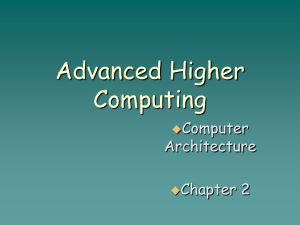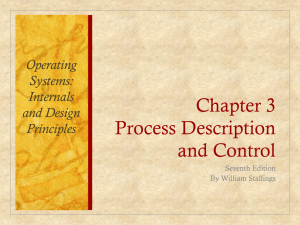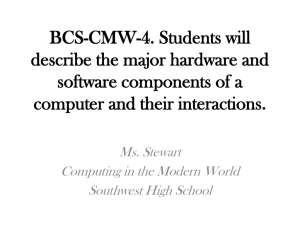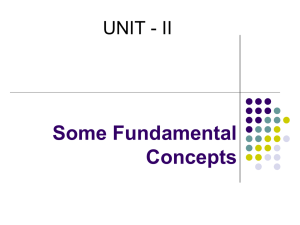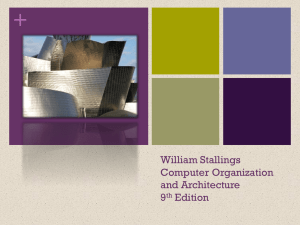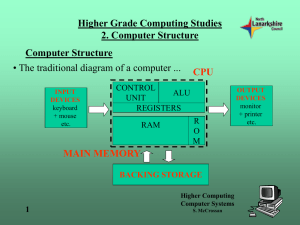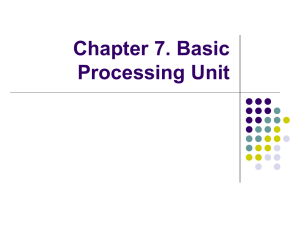File
advertisement
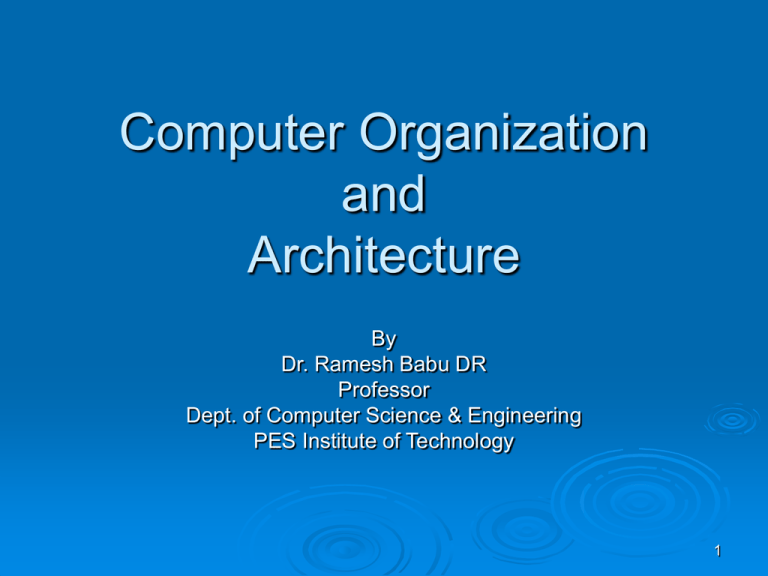
Computer Organization and Architecture By Dr. Ramesh Babu DR Professor Dept. of Computer Science & Engineering PES Institute of Technology 1 References 1. “Computer Organization”,Carl Hamacher, Zvonko Vranesic and Safwat Zaky, Fifth Edition, McGrawHill 2. “Computer Organization and Design”, Davis A Patterson & John L Hennessy, Third Edition, Elsevier 3. “Computer Architecture: A Quantitative Approach”, John L Hennessy & Davis A Patterson 2 Contents Today’s Lecture will cover: - Introduction to Computers - Various Application of Computers - Generation of computers - Classes of Computing Applications - Understanding Program Performance - Below your Program - High-Level Language to the Language of Hardware 3 Contents - Inside the Computer - Communication with Other Computers - Technologies for Building Processors and Memories - Real Stuff : Manufacturing Pentium 4 Chips - Basic Operational Concepts 4 Definition of a Computer What is it? A Computer is a machine capable of manipulating data in complex, programmable ways. wikipedia 5 Generations • • • • • First generation Computer, 1940-1956, defined by Vacuum tubes. Second generation Computer, 1956-1963, defined by Transistors Third generation Computer, 1964-1971, defined by Integrated Circuits (IC) Fourth generation computer, 1971-today, defined by Microprocessors Fifth generation computer, Present and Beyond, defined by Artificial Intelligence (AI) 6 GENERATION 0 : MECHANICAL COMPUTERS (1642-1945) Abacus Pascal’s Mechanical Calculator 7 GENERATION 0 : MECHANICAL COMPUTERS (1642-1945) Leibniz Calculator 8 GENERATION 0 : MECHANICAL COMPUTERS (1642-1945) Programmable devices Jacquard’s loom 9 GENERATION 0 : MECHANICAL COMPUTERS (1642-1945) Babbage’s Difference Engine 10 First Generation(1940-1956) Stored Program Concept(John von Neumann) Vacuum tubes 11 Second Generation(1956-1963) Transistor Development of programming languages (COBOL, FORTRAN) 12 Third Generation(1964-1973) IC technology Microprogramming, parallelism, pipelining Cache memory, Virtual memory 13 Fourth Generation(1973-1985) VLSI technology Microprocessors LAN, WAN, Internet 14 Beyond the Fourth Generation(1985-??) AI Parallel processing Networking 15 Classes of Computing Applications • Desktop Computers Workstations Mainframes Supercomputers Minicomputers • Servers • Embedded computers 16 Desktop Computer A Computer designed for use by an individual, usually incorporating a graphics display, keyboard and mouse 17 Servers A computer used for running larger programs for multiple users often simultaneously and typically accessed only via network 18 Supercomputers A class of computers with the highest performance and cost; they are configured as servers and typically cost millions of dollars - Tsubame - Earth simulator - Param Supercomputer 19 Embedded computer A computer inside another device used for running one predetermined application or collection of software 20 Handheld/Pocket PC Desktop PDA Tablet PC Laptop 21 Workstation 22 Mainframe 23 Supercomputer 24 Understanding Program Performance The performance of a program depends on a combination of the effectiveness of the algorithms used in the program, the software systems used to create and translate the program into machine instructions, and the effectiveness of the computer in executing those instructions 25 Below your Program Application software System software Hardware 26 System Software Software that provides services that are commonly useful, including operating system, compilers and assemblers 27 Operating System Supervising program that manages the resources of a computer for the benefit of the programs that run on that machine 28 Complier A Program that translates language statements into language statements high-level assembly 29 High-Level Language to the Language of Hardware Assembler – A program that translates a symbolic version of instructions into the binary version Assembly language A symbolic representation of machine instruction 30 High-Level Language to the Language of Hardware A portable language such as C, Fortran, or Java composed of words and algebraic notation that can be translated by a complier into assembly language 31 Under the covers Five Classic components of computer - Input - Output - Memory - Datapath - Control Processor 32 Input A mechanism through which the computer is fed information, such as the keyboard, mouse, scanners, etc… 33 Output Device A Mechanism that conveys the result of a computation to a user or another computer 34 Opening the Box Motherboard – A plastic board containing packages of ICs, including processor, cache memeory, and connectors for I/O devices such as networks and disks IC- Also called Chip A device combining dozens to millions of transistors 35 Opening the Box Memory – The storage area in which programs are kept when they are running and that contains the data needed by the running programs Central Processor Unit (CPU) Also called processor. The active part of the computer, which contains the datapath and control and which adds numbers, tests numbers, signals I/O devices to activate, and so on.. 36 Datapath – The component of the processor that performs arithmetic operations Control – The component of the processor that commands the datapath, memory, and I/O devices according to the instructions of the program 37 DRAM – Memory built as an integrated circuit, it provides random access to any location Cache Memory – A small, fast memory that acts as a buffer for a slower, larger memory 38 Last week question What is liquid Crystal in LCD display. crystal – substance that has properties between those of a conventional liquid and a solid Liquid 39 Liquid crystal flow like a liquid, but have the molecules in the liquid arranged and oriented in a crystal-like way. LCD Display is a thin, flat display device made up of any number of color or monochrome pixels arrayed in front of a light source or reflector. Each pixel consists of a layer of liquid crystal molecules suspended between two transparent electrodes and two polarizing filters, the axes of polarity of which are perpendicular to each . 40 A safe place for data Memory – The storage area in which programs are kept when they are running and that contains the data needed by the running programs Volatile Memory – Storage, such as DRAM, that only retains only if it is receiving power 41 Nonvolatile memory – A form of memory that retains data even in the absence of a power source and that is used to store programs between runs. Magnetic disk is nonvolatile and DRAM is not. 42 Primary Memory : Also called main memory. Volatile memory used to hold programs while they are running; typically consists of DRAM in today’s computers Secondary Memory : Nonvolatile memory used to store programs and data between runs; typically consists of magnetic disks in today's computers 43 Magnetic disk ( Also called Hard disk ) A form of nonvolatile secondary memory composed of rotating platters coated with a magnetic recording material 44 Communicating with other computers Network LAN WAN Advantages -Communication - Resource Sharing - Nonlocal access 45 Technologies for Building processors and Memories Silicon – A natural element which is a semiconductor Semiconductor – A substance that does not conduct electricity well 46 Real Stuff: Manufacturing Pentium 4 Chips Silicon ingot Slicer Blank wafers Patterned wafers Wafer tester Dicer Tested dies 47 48 Moore’s law in Microprocessors Transistors (MT) 1000 2X growth in 1.96 years! 100 10 486 1 386 286 0.1 0.01 P6 Pentium® proc 8086 8080 8008 4004 8085 0.001 1970 1980 1990 Year 2000 2010 Transistors on Lead Microprocessors double every 2 years Courtesy, Intel 49 Metrics to evaluate a Computer Metrics Speed – delay, frequency Power Dissipation Energy to perform a function Cost Scalability Reliability 50 Basic Operational Concepts To perform a given task, an appropriate program consisting of a list of instruction is stored in the memory. Individual instructions are brought from the memory into the processor, which executes the specified operation. 51 Add LOCA, R0 Load LOCA, R1 Add R1, R0 52 Memory MAR MDR Control PC R 0 R 1 Processor IR ALU R n- 1 n general purpose registers Connections between the processor and the memory 53 Terms used IR - instruction currently being executed PC - memory address of next instruction to be fetched and executed MAR - address of location to be accessed MDR - data to be written into or read out of the addressed location Interrupts and ISRs 54 Functions… Instruction Register : contains the instruction that is being executed. Its output is available to the control circuits, that generates the timing signals for control of the actual processing circuits needed to execute the instruction. 55 Program Counter : is a register, that contains the memory address of the instruction currently being executed. During the execution of the current instruction, the contents of program counter is updated to correspond to the address of the next instruction. 56 Memory Address Register (MAR) : holds the address of the memory location to or from which data is to be transferred. Memory Data Register (MDR): contains the data to be written into or read-out of the addressed memory location. 57 General- purpose Registers : are used for holding data, intermediate results of operations. They are also known as scratch-pad registers. 58 Steps involving instruction fetch and execution INSTRUCTION FETCH Execution of a program starts by setting the PC to point to the first instruction of the program. The contents of PC are transferred to the MAR and a Read control signal is sent to the memory 59 The addressed word (here it is the first instruction of the program) is read out of memory and loaded into the MDR The contents of MDR are transferred to the IR for instruction decoding 60 INSTRUCTION EXECUTION The operation field of the instruction in IR is examined to determine the type of operation to be performed by the ALU The specified operation is performed by obtaining the operand(s) from the memory locations or from GP registers. 61 Fetching the operands from the memory requires sending the memory location address to the MAR and initiating a Read cycle. The operand is read from the memory into the MDR and then from MDR to the ALU. The ALU performs the desired operation on one or more operands fetched in this manner and sends the result either to memory location or to a GP register. 62 The result is sent to MDR and the address of the location where the result is to be stored is sent to MAR and Write cycle is initiated. Thus, the execute cycle ends for the current instruction and the PC is incremented to point to the next instruction for a new fetch cycle. 63 Bus Structures – Group of lines (wires) that serves as a connecting path for several devices BUS Single-bus structure 64 Data Bus : It is used for transmission of data. The number of data lines correspond to the number of bits in a word. Address Bus: it carries the address of the main memory location from where the data can be accessed. Control Bus: it is used to indicate the direction of data transfer and to coordinate the timing of events during the transfer 65 Bus Structures Single-bus structure Two-bus structure 66 Input Output Memory Processor Single-bus structure • Only two units can actively use the bus at any given time • Devices connected to bus vary in speed 67 Advantages of Single-Bus Structure Low Cost Flexibility for attaching peripheral devices Draw Back low operating speed Found in small computers such as minicomputers and microcomputers. 68 TWO-BUS STRUCTURE I/O bus Input Memory Processor Output 69 The bus is said to perform two distinct functions by connecting the I/O units with memory and processor unit with memory. The processor interacts with the memory through a memory bus and handles input/output functions over I/O bus. The main advantage of this structure is good operating speed but on account of more cost. 70 Performance Performance - measure of how quickly the computer can execute programs – Design of Hardware and its machine Language Speed Performance – Design of compiler, Machine instruction set, and the hardware in a coordinated way Best 71 Execution depends on all units in a computer system Processor Time depends on the hardware involved in the execution of individual machine Instruction Main memory Cache memory Processor Bus 72 Processor Clock Processor circuits are controlled by timing signal called clock Clock cycle – regular time interval If P – length of one clock cycle is an important parameters that effects processor performance Hertz (Hz) – cycles per second 73 500 millions cycles per second – 500 MHz 1250 millions cycles per second – 1.25 GHz 74 Basic Performance Equation T = NxS R T – processor time(program execution time) N – number of instruction executions S – avg. no. of basic steps to execute 1 machine instruction R – clock rate 75 Instruction Set RISC ( Reduced Instruction Set Computers) CISC ( Complex Instruction Set Computers) 76 77 Multiprocessors and Multicomputers Shared-memory multiprocessor systems Message-passing multicomputers 78




